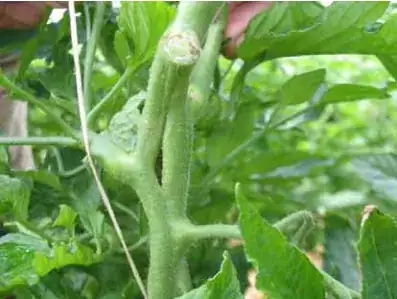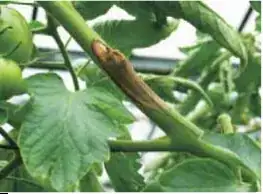I am unsure, but I will try a couple of answers.
1. A physiological disorder
Alterations of non-parasitic, which also affect the tomato in protected cultivation. Such changes may result from the different organs of the plant and are due to climatic conditions, to technical management and cultural inaccurate, and varietal genetic predispositions.
Cracking of the stem
It is caused by an excess of vigor that influence the dominance exerted by the apical meristem on secondary meristem, following which the tissues that make up the frame are developed in an unbalanced way causing the characteristic cracking.

In my opinion, there are not possible interventions.
2. An human error.
Alterations caused by hormonal substances and pesticides.
They can also be caused by poisoning from herbicides hormones (2,4 D, MCPA, etc.) Used in the weeding of wheat and that in some cases through the drift of the treatment have determined damage to tomato crops in the greenhouse.
Sometimes they are found damage to the vegetative apparatus, due to an overdose of pesticides or the use of the same in particular environmental conditions.
Some formulations applied to soil can cause alterations in the vicinity of the neck due to longitudinal cracks, callus formation and suberificazion (transformation of the membrane of plant cells in cork) of surface.
Experiences in this regard have been detected in crops preceded by treatment with sodium Metham, Dicloran or with residual herbicides.
If you do not know where it comes from the soil you used, it is possible that the seller has picked it up from a contaminated soil.


Your plant is very young so the disorder is in its infancy, still green.
Again I do not think we can do much, if not groped to change all the substrate. But it is a very delicate operation, which could cause further damage.
Not to mention that, in the absence of a clear diagnosis, it is not at all sure that we can obtain results of any kind.
http://www.sardegnaagricoltura.it/documenti/14_43_20081120154000.pdf




